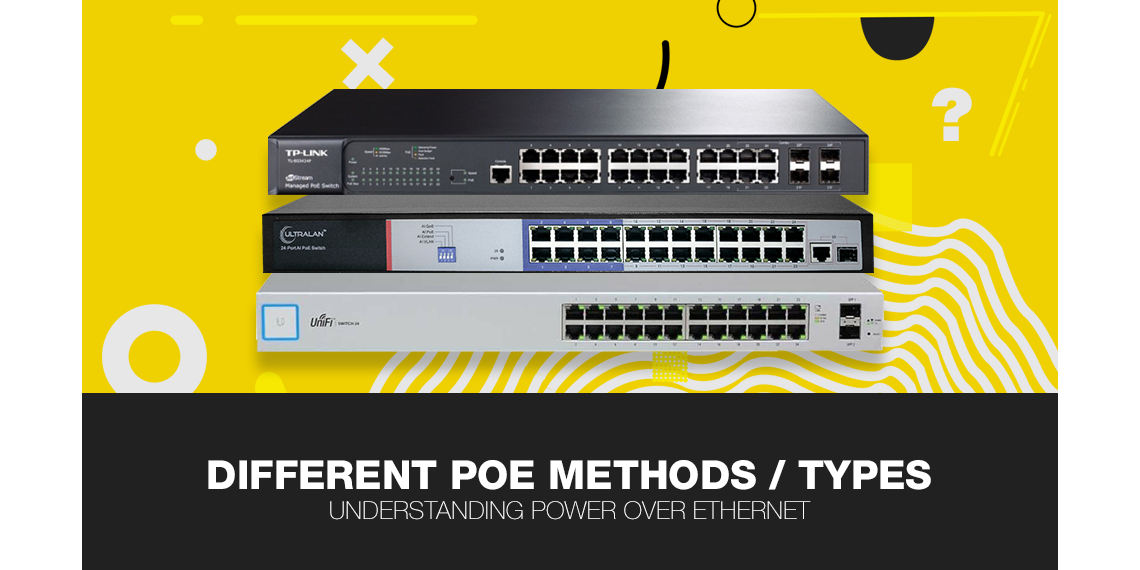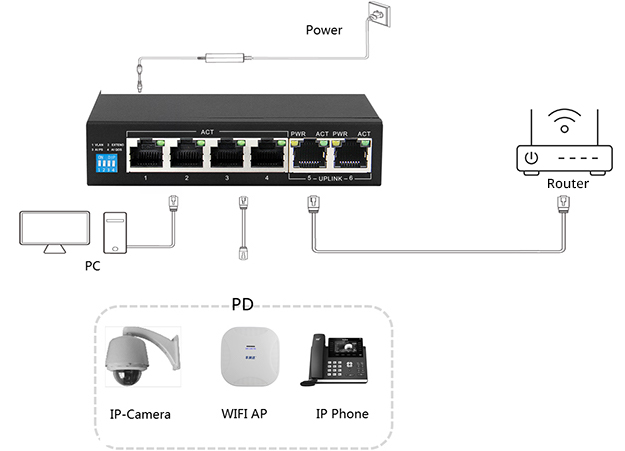
Did you know there are different PoE types?
Understanding different PoE methods
PoE (Power over Ethernet) is a convenient method that powers network devices without needing to have a 220V AC wall socket nearby. As the name implies, power is carried directly over the Ethernet (CAT5e/CAT6) cabling to the network device. This is especially handy if (for example) you only have a 220V AC wall socket on the floor, but you need to mount your WiFi AP in a ceiling, or if you have a security camera outside against a wall with no AC power close by.
All PoE devices are not created equal though, and it is important to note the differences between these PoE methods and to select the correct one for your installation and devices.
The most common PoE types are Passive PoE, and Active PoE, and we’ll go through a run-down of each below so that you have a better understanding of each:
Passive PoE
The major difference is that Passive PoE works on a principle of "the voltage you put in, is the voltage you get out". If the Power Supply is 12V, the Passive Poe Injector will inject 12V onto the network cable; if it’s a 24V power source, you’ll get 24V out of the PoE injector, and so forth.
Passive PoE commonly uses Pin 4 & 5 for DC Positive (VDC+) while Pin 7 & 8 is used for DC Negative (VDC-).
Example images of passive PoE injectors:

Passive PoE is ‘always on’, so it’s important to only connect a device that is expecting power into a PoE injector as there will always be a current on the network cable. Plugging a laptop that’s not expecting power on its RJ45 port into a Passive PoE injector is dangerous, as you might blow circuitry and end up with a dead RJ45 port on your laptop.
As Passive PoE injects the voltage you supply directly into the Ethernet cable, you also get voltage loss the longer your network cable run is (cable resistance affects voltage loss too). Passive PoE requires less electronics/circuitry to get added to the devices, and as such it is generally a more cost-effective way to implement PoE on a lower-cost product. Devices that use Passive PoE would also state their required voltage, and it is recommended to use the PoE injector that is supplied along with the product.
Active PoE
There are two versions of Active PoE, namely IEEE 802.3af and 802.3at (also known as PoE+).
- 802.3af was first standardized by the IEEE commission, and this standard can supply up to 15.4W of power (typically per port, if it is a PoE switch).
- 802.3at was ratified a few years later, and this standard is able to drive more power-hungry devices as it can supply up to 25.5W of power.
Example diagram of a 802.3af PoE switch deployment:

As these power methods follow a standard, it means that any 802.3af/at injector device (such as a PoE switch) will power any brand 802.3af/at PD (PD=Power Device, such as an IP camera or WiFi Access Point), as they all adhere and work on the same standard. This makes it more flexible for installations, as you don’t have to be concerned that you require a specific voltage or brand of PoE to power your devices.
802.3af/at also has some ‘smart functionality’, as the PoE source (switch or injector) will automatically negotiate the voltage with the PD. When you plug an IP phone into the Active PoE switch, the switch will automatically send the correct voltage out on that port, and it will also negotiate what pins to send power on to the IP phone. The switch will also adjust the voltage depending on the cable length and resistance, which allows you to still power up a device correctly even over very lengthy cables.
For 802.3af/at to work correctly and do the negotiation, both the power source (PoE switch) and the PD (Power Device) needs to support the same protocol (802.3af or 802.3at). It’s thus also safer, as you can plug a laptop into a 802.3af/at PoE switch and no damage will be done to the laptop’s RJ45 port (if the switch does not negotiate power with the PD successfully, it simply does not send power on that port).
802.3af/at is more robust, but it's usually more expensive compared to Passive PoE implementations.
Unfortunately, Passive and Active PoE is not inter-operable, and it’s therefor important to double check what type of PoE is required by your device (this is normally stated on the datasheet of products) and to make sure that you use the correct PoE Switch or PoE injector to power your network devices.
In summary, Passive PoE just sends out the same voltage that it is supplied, while 802.3af/at will automatically negotiate the correct power requirements (voltage/pins) with the PD.
Uniterm Direct offers a wide range of PoE injectors and switches for any installation. All of our PoE and Power products can be viewed on our website here:


